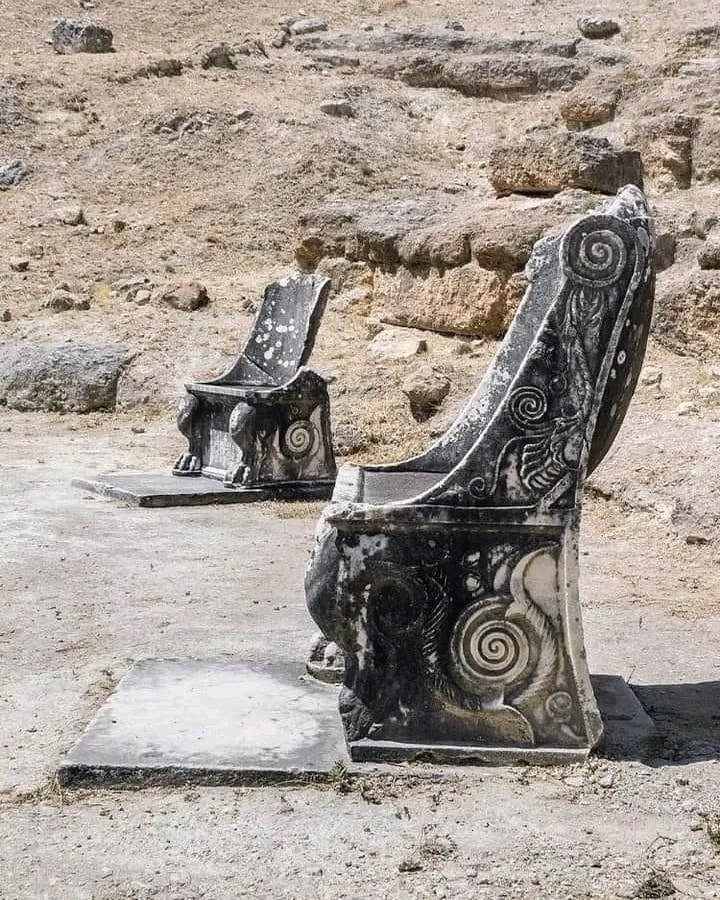In the historic town of Oropos, Greece, lies an extraordinary relic of ancient Greek civilization—the Amphiareion Theatre. This sacred site is home to a set of marble thrones, known as Prohedria, which have withstood the test of time for over two thousand years. These enduring seats offer more than just a physical link to the past—they provide a window into the cultural, religious, and social complexities of ancient Greek life. Each carefully carved stone throne is a silent witness to a society that deeply valued art, religion, and social order, allowing modern observers to glimpse a world where status and community roles were etched not only in the hearts of citizens but also in the very architecture that surrounded them.

The Prohedria thrones represent the sacred seats of power in a society that revered hierarchy and public life. Carved from durable marble and positioned prominently in front of the stage, these seats were reserved for the most esteemed individuals in ancient Greek society—high-ranking officials, revered priests, and other influential figures who played pivotal roles in civic and religious life. Their placement at the forefront of the theater, offering an unobstructed view of performances and ceremonies, was a visual and social affirmation of the occupant’s authority and distinction.
More than mere seating, these thrones were symbols of honor, carefully crafted to reflect the importance of those who sat upon them. Ancient Greek artisans, renowned for their precision and artistry, selected marble for its strength and natural beauty. This material choice has proven wise, as these thrones continue to endure millennia after their creation. Each Prohedria throne is adorned with intricate carvings and motifs—design elements that likely held symbolic meaning, perhaps reflecting the identity or social rank of the person who occupied it. The elegance of the craftsmanship not only underscores the technical skill of Greek stonemasons but also speaks to the cultural value placed on artistry and refinement.
The Amphiareion Theatre itself was no ordinary venue. Situated within a sanctuary dedicated to Amphiaraus—a mythological hero, healer, and prophet—the site served both spiritual and civic functions. Visitors would come to this sanctuary not only to witness dramatic performances but also to seek divine counsel through religious rituals. The blending of these two aspects—entertainment and spirituality—highlights the deeply intertwined nature of public and religious life in ancient Greece. It was a space where art met the divine, and where community members gathered to experience both the joys of performance and the solemnity of worship.
The role of theatre in ancient Greek society cannot be overstated. Far beyond its function as entertainment, theatre was a foundational element of civic life. Through the dramatic arts, Greek citizens engaged with profound questions of morality, philosophy, and the human experience. Plays often depicted the lives of gods, heroes, and historical figures, allowing audiences to reflect on their own values and societal norms. Attending the theatre was both an educational and communal activity, one that reinforced civic identity and collective values.
The discovery of the Prohedria thrones has provided archaeologists and historians with critical insights into the social structures and cultural priorities of ancient Greece. The strategic placement of these thrones near the stage—the best seats in the house—illustrates the emphasis on social hierarchy and the importance of public display. These seats were not merely practical; they were part of a larger architectural narrative that physically manifested social order and reverence for authority. Their survival offers invaluable evidence of how ancient Greeks organized communal spaces and emphasized distinction through design.
Today, standing before the Prohedria thrones at the Amphiareion Theatre is like stepping into a different era. These seats are more than stone—they are living symbols of a civilization that contributed profoundly to the development of modern Western thought, governance, and art. They represent a society where public life was deeply valued, where theatrical performance was both a mirror and a guide for personal and communal reflection, and where social status was visibly honored in shared spaces.
The presence of these thrones also serves as a powerful reminder of the lasting impact of ancient Greek civilization. The philosophical, artistic, and political innovations born in places like the Amphiareion continue to influence the modern world. From democratic ideals to architectural styles, the legacy of ancient Greece endures in many facets of contemporary life. The Prohedria thrones stand not only as archaeological artifacts but as bridges to that rich legacy—inviting modern audiences to connect with the past and appreciate the enduring contributions of Greek culture.
For visitors, the experience of seeing the Prohedria thrones in their original setting is a moving one. One can almost hear the echoes of ancient voices—the laughter, the applause, the solemn chants—reverberating through time. These thrones, once occupied by the elite of a vibrant society, now welcome the gaze of curious travelers, scholars, and enthusiasts, each eager to understand the world that created them.
In conclusion, the marble Prohedria thrones of the Amphiareion Theatre are far more than remnants of stone. They are artifacts that embody the artistic mastery, social consciousness, and cultural richness of ancient Greece. Their existence helps us appreciate the foundations of Western civilization, illuminating how a society honored its leaders, valued public life, and celebrated the arts. As we continue to study and preserve such treasures, we not only gain knowledge but also deepen our connection to the timeless human desire for meaning, beauty, and order in the shared spaces we create. Through these thrones, the voices of the past speak to us still, offering insights and inspiration for generations to come.





